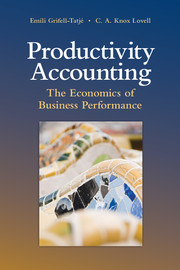Book contents
- Frontmatter
- Dedication
- Contents
- List of Tables
- List of Figures
- Preface
- 1 Introduction
- Part I Productivity and Profitability
- Part II Productivity and Profit
- 4 Profit Change: Its Generation and Distribution
- 5 Decomposing the Quantity Change and Price Change Components of Profit Change
- 6 Decomposing the Productivity Change Component of Profit Change
- Part III Productivity, Cost, and Return on Assets
- Bibliography
- Author Index
- Subject Index
5 - Decomposing the Quantity Change and Price Change Components of Profit Change
Published online by Cambridge University Press: 05 January 2015
- Frontmatter
- Dedication
- Contents
- List of Tables
- List of Figures
- Preface
- 1 Introduction
- Part I Productivity and Profitability
- Part II Productivity and Profit
- 4 Profit Change: Its Generation and Distribution
- 5 Decomposing the Quantity Change and Price Change Components of Profit Change
- 6 Decomposing the Productivity Change Component of Profit Change
- Part III Productivity, Cost, and Return on Assets
- Bibliography
- Author Index
- Subject Index
Summary
Introduction
This is the second of three chapters dealing with the generation and distribution of profit and its change. In Chapter 4 we provided an introduction, largely historical, to the subject. In this chapter we take a somewhat more analytical approach based on empirical indicators, the difference analogues to empirical indexes that are expressed in ratio form. As in Chapter 4, we attribute profit change to change in quantities (the quantity effect) and change in prices (the price effect), and we explore the distribution of the financial impacts of quantity change. However, the introduction of empirical indicators enables us to identify and characterize two components of the quantity effect and two components of the price effect. An analysis of these two decompositions forms the core of Chapter 5. In Chapter 6 we consider various approaches to the search for the economic drivers of productivity change. In all three chapters profit change is expressed in monetary units. Consequently, the impacts of productivity change and its economic drivers are expressed in monetary units.
The primary issue in this chapter concerns whether or not, and if so under what conditions, the quantity effect measures the contribution of productivity change to profit change. Our discussion in Section 4.3 of Chapter 4 suggested that it does not, except under restrictive conditions involving the presence of investor input in the model, a suggestion that was confirmed by the numerical illustration in Section 4.5. A closely related issue concerns the economic interpretation of any deviation between the quantity effect and the productivity effect. In Chapter 4 we referred to the complement of the productivity effect in the quantity effect as a (quantity) margin effect, a nomenclature we retain in this chapter. A second, and equally important, pair of issues concerns whether or not, and if so under what conditions, the price effect measures the contribution of price recovery change to profit change, together with an economic interpretation of any deviation between the price effect and the price recovery effect. We adopt similar terminology to characterize any deviation between the two as a (price) margin effect.
- Type
- Chapter
- Information
- Productivity AccountingThe Economics of Business Performance, pp. 202 - 232Publisher: Cambridge University PressPrint publication year: 2015



